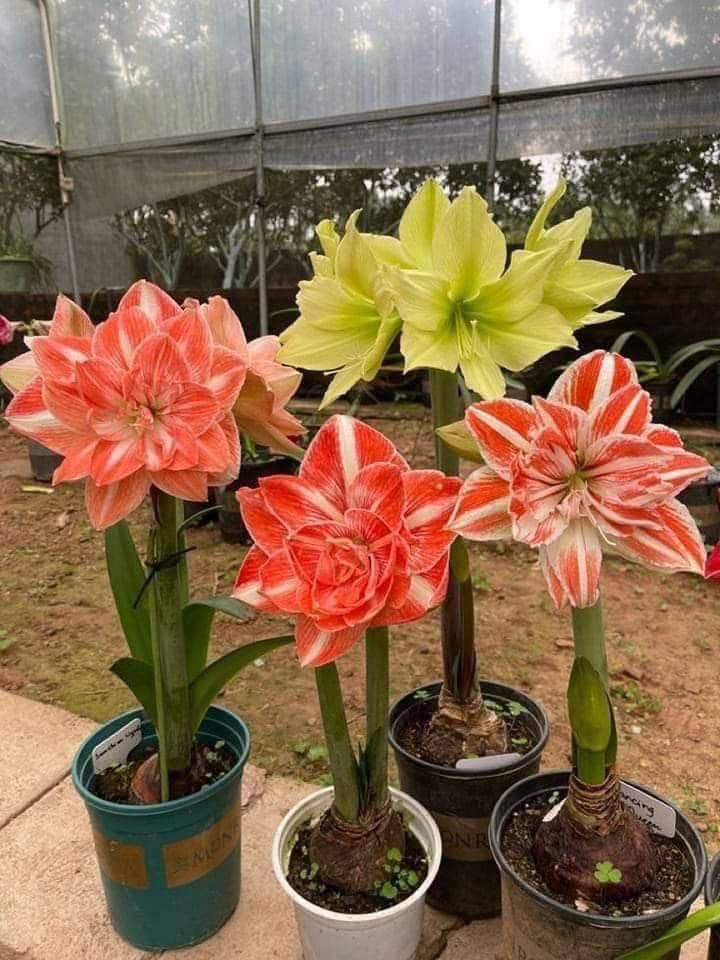The Amaryllis (Hippeastrum) is a stunning and dramatic flowering plant that graces many homes with its bold and elegant blooms. Known for its large, showy flowers in shades ranging from vibrant reds and pinks to pure whites, this plant is a favorite during the holiday season. One variety, in particular, features pristine white petals with a delicate red or pink rim, creating a beautiful contrast that adds a touch of sophistication to any space.
With proper care and attention, an Amaryllis can bloom year after year, offering you a consistent source of beauty. Here’s a comprehensive guide on how to grow and care for this captivating flower.
Ideal Growing Conditions for Amaryllis
To ensure your Amaryllis thrives and produces beautiful blooms, it’s essential to provide the right growing conditions. Here’s a breakdown of the key care elements:
1. Light: Bright, Indirect Sunlight
Amaryllis plants thrive in bright, indirect sunlight. A sunny windowsill is an excellent spot for them, where they can receive plenty of light without the risk of direct sunlight. While they love light, direct sun—especially during the hottest parts of the day—can scorch their delicate leaves and flowers. Therefore, place them where they can enjoy the light but are shielded from the harsh midday rays.
2. Temperature: Ideal Room Temperatures
Amaryllis prefers average room temperatures, typically ranging between 60°F to 75°F (15°C to 24°C). They’re not fans of extreme heat or cold, so it’s essential to keep them in a warm, stable environment that mimics their native tropical habitat. Avoid placing them near drafts, air conditioning vents, or heaters that could fluctuate the temperature too much.
3. Watering: Proper Moisture Management
Watering is one of the most critical factors in Amaryllis care, and getting it right is key to keeping your plant healthy.
Initial planting/after dormancy: After planting the bulb, or when you wake it from dormancy, water it very sparingly. The bulb does not need much water until you see new growth emerging, such as a flower stalk or leaves. Overwatering at this stage can cause the bulb to rot, so it’s crucial to wait until signs of growth appear.
During growth and flowering: Once the flower stalk and leaves begin to grow, you can increase watering. Water your Amaryllis when the top inch of soil feels dry. Be sure the pot has drainage holes to allow excess water to escape, preventing waterlogging. Never let the bulb sit in water, as it can cause root rot.
After flowering: When the blooms fade, cut back the flower stalk to near the top of the bulb, but do not cut the leaves. The leaves continue to photosynthesize, storing energy for the bulb’s next blooming cycle. Keep watering and fertilizing regularly to help the bulb store energy. Once the leaves naturally yellow and die back, reduce watering gradually and prepare for the dormant period.
4. Soil: Well-Draining Potting Mix
Amaryllis prefers a well-draining potting mix. A good mix might include equal parts of potting soil, perlite, and coarse sand or bark chips. This allows for proper drainage, ensuring the bulb’s roots do not sit in water and become prone to rot. When planting your bulb, make sure the soil is well-aerated, which is critical for healthy root development.
5. Potting: Choosing the Right Container
When potting an Amaryllis, choose a pot that’s just slightly larger than the bulb. Aim for a pot that has about 1-2 inches of space between the bulb and the edge. This helps prevent the bulb from being waterlogged while also giving it enough room to grow. Plant the bulb so that about the top third or “neck” is visible above the soil surface. This ensures that the bulb has adequate space to grow and allows for proper drainage.
6. Dormancy (Resting Period)
One of the key aspects of growing Amaryllis is allowing it to undergo a dormant (resting) period after the flowers have faded. Once the foliage has completely died back, it’s time to stop watering. Cut the dead leaves back and store the pot in a cool, dry, dark place (about 50°F to 60°F or 10°C to 15°C) for around 6-8 weeks. During this rest period, the bulb regenerates energy for the next blooming season.
After the resting period is over, you can repot the bulb with fresh soil and start the growing cycle again, encouraging it to bloom once more.
Key Care Tips for Amaryllis
Here are a few key takeaways to keep in mind for successful Amaryllis care:
Watering is crucial: Avoid overwatering during dormancy and the initial planting phase. Proper watering during the active growing and flowering phases is essential.
Provide a rest period: The bulb needs a dormancy period to rest and regenerate for its next blooming season.
Bright, indirect light: To encourage strong growth and abundant blooms, provide plenty of light without exposing the plant to harsh direct sunlight.
Fertilization: During the active growing season, feed your Amaryllis with a balanced fertilizer every 3-4 weeks to promote healthy growth and blooms.
Conclusion: A Magnificent Blooming Houseplant
The Amaryllis is a truly magnificent plant that rewards careful attention with breathtaking blooms year after year. Its beautiful white petals with red or pink edges make it a striking focal point in any indoor space. Whether placed on a windowsill, in a decorative pot, or as part of your seasonal décor, the Amaryllis will certainly impress.
By following the proper care tips, providing it with a comfortable growing environment, and respecting its dormancy period, your Amaryllis will not only thrive but continue to bloom beautifully season after season. So, add this stunning flower to your home and let its elegant blossoms light up your space!
Happy Gardening! 🌷
More Articles You Might Like
-
Texas Toast Sloppy Joes: The Crunchy, Cheesy Upgrade You Didn’t Know You Needed
There’s something timeless about sloppy joes. For generations, this saucy, savory, and slightly sweet ground beef sandwich has been a go-to comfort food in American kitchens. It’s quick, filling, and family-friendly—perfect for busy weeknights. But what if we told you there’s a way to take this classic dish up a notch? Enter the Texas Toast…
-
Classic Pig Pickin’ Cake
When it comes to Southern desserts, few sweets shine as brightly as the Classic Pig Pickin’ Cake. This nostalgic cake, sometimes called a “Mandarin Orange Cake,” has roots deep in Southern tradition. It gets its playful name from its frequent appearance at pig pickin’s—Southern-style barbecue gatherings where communities come together to enjoy slow-cooked pork, sides,…
-
Lemon Garlic Butter Chicken with Creamy Parmesan Pasta
There’s something irresistible about the combination of tender, golden-browned chicken paired with a creamy pasta coated in Parmesan cheese. Add the brightness of lemon, the depth of garlic, and the richness of butter, and you have a recipe that feels indulgent yet approachable enough for a weeknight dinner. Lemon Garlic Butter Chicken with Creamy Parmesan…



